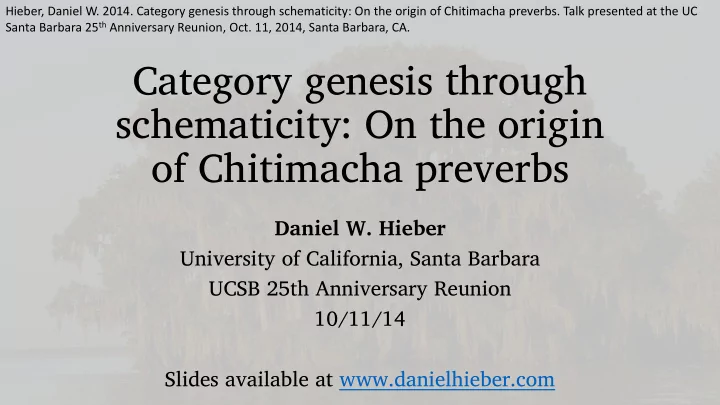

Hieber, Daniel W. 2014. Category genesis through schematicity: On the origin of Chitimacha preverbs. Talk presented at the UC Santa Barbara 25 th Anniversary Reunion, Oct. 11, 2014, Santa Barbara, CA. Category genesis through schematicity: On the origin of Chitimacha preverbs Daniel W. Hieber University of California, Santa Barbara UCSB 25th Anniversary Reunion 10/11/14 Slides available at www.danielhieber.com
The Chitimacha Language
Chitimacha Preverbs hi to, going his back to, returning there Form a semantic unit with • the verb, often lexicalized kap up; suddenly; INCEP, INCH, STAT kaːpʼs back up Add directional and • aspectual meanings kas back across, returning across; apart, REV Plain and reversative pairs ka across, going across • ni thing; down; INTR, NZR, IMP Originate in verbs, • postpositions, nouns, and ʔap here, coming possibly adverbs ʔapš back here, returning here
Chitimacha Preverbs hi čuw- ‘go (to)’ • eːnink š hup hi ničwiʔi • kas čuw- ‘go back; return’ pond.LOC to POST to PREV he.came.to.water • ‘he came to a pond’ ni čuw- ‘go down; decrease’ • ʔap čuw- ‘go here; come’ • kap ʔučʼikiːkʼš naʔa ʔap š čuw- ‘go about; wander’ • • INCH be.rotten-PTCP-SUBORD they.are ‘they have become rotten’ kas ʔiːkšt- ‘sharpen s.t.’ • ni wopma- ‘ask s.t.’ •
The Problem • How did this class of preverbs arise? • Not by analogy to other preverbs – they didn’t existǃ • Not by analogy to just one preverb – not a strong category • Solution: By analogy to each other , taking advantage of light paradigmaticity (‘ schematicity ’) across different constructions
Diachronic Origins: ni ‘down; INTR’ < ni ‘thing’ • No other unanalyzable word for ‘thing’ in modern Chitimacha • > detransitivizer: čuht- ‘build s.t.’ vs. ni čuht- ‘build’ • > compound nominalizer: • š aːpniš ni poʔ ‘rattlesnake medicine’ • hi čʼiːpampa ni čʼah ‘pet bird’ • Another root ni- ‘down’ merged with ni ‘thing’ into one preverb • niihkup ‘down’ < niihk- + hup ‘to’ < ni- ‘down’ + -h ‘in’ + -k PTCP • neh - ‘go down into’ • nih - ‘turn over’ (lit. ‘turn down’) < ni- ‘down’ + -h ‘in’ •
Diachronic Origins: ʔap ‘here; coming’ < ʔap- ‘come’ • No modern unanalyzable verb meaning ‘come’ • Matches CVC pattern for verb roots • > serial verb construction: ʔap mači- ‘come (and) bring’ • > adverbial function?: ʔap čuw- ‘go here’ •
Diachronic Origins: ʔapš ‘return here; REFL/RECIP’ ʔap ‘come’ + -s / -š REVERSATIVE • REV is a verbal suffix – more evidence for ʔap as originally verbal • > serial verb construction: ʔapš heyšt- ‘come back and pick (it) • up’ • ‘go and come back’ > ‘about; randomly’ • ‘back here’ > ‘back together’ > adverbial construction: ʔapš heːčt- ‘meet together’ > REFL / RECIP
Diachronic Origins: hi ‘to; going to’ < postposition hi ‘to’ • < hi- ‘be’?: ‘be at’ > ‘to’? • < hi- ‘go’? – No unanalyzable verb for ‘go (to)’ in modern Chitimacha • • [ waʔank hi PP ] pešiʔi ‘he flew [to the other side]’
Diachronic Origins: his ‘back to; undoing, redoing; doing in response’ hi ‘to’ + -s / -š REVERSATIVE • serial verb: ‘go back and do’ > ‘go back and do again’ • adverbial: ‘do back’ > ‘do in response’ •
Diachronic Origins: kap ‘up; suddenly; STAT, INCH, INCEP’ < ka(ː)p- ‘go up’ • adverbial: ‘go up’ > ‘up’ • serial verb: ‘go up and verb’ > ‘up and verb suddenly’ > ‘up • and become verb’ INCEP / INCH > ‘be verb’ STAT
Diachronic Origins: kaːpʼs ‘returning up’ < ka(ː)p- ‘go up’ + -s / -š REVERSATIVE • Occurs 7x in the corpus • Still very adverb -like in its uses – no clear lexicalized cases •
Diachronic Origins: kas ‘returning there; reverse; apart’ < kaʔ- ‘extend across’ + REVERSATIVE • adverbial: ‘back across’ > ‘returning there’ > ‘back apart’ • serial verb: ‘go back across and verb’ > ‘go back across’ > • ‘reverse’
Diachronic Origins: ka (?) ‘going across’ < kaʔ- ‘extend across’ • ka is a hapax legomenon – occurs 1x in the texts • we kimuš ney=up ka nenštk • the branch land=to across going.out.of.water ‘bringing the branch out of the water across to land’
Schematicity Across Constructions Syntactic Commonalities Semantic Commonalities hi ‘to’ Adv V • • his ‘back to’ • • V SUBORD V MAIN kap ‘go up’ • • [N PP] V kaːpʼs ‘go back up’ • • N OBJ V ka ‘go across’ • kas ‘go back across’ • ni ‘go down’ • ʔap ‘come’ • Preverbal ʔap š ‘come back’ • Directional
Conclusion The class of Chitimacha preverbs did not emerge one word at a • time, but rather as a category as a whole As each preverb developed its directional meaning and • increased in frequency preverbally, speakers latched onto the schematicity across the different constructions Speakers reanalyzed each of these constructions on the basis of • this cross-constructional analogy
Recommend
More recommend